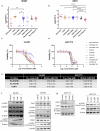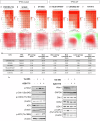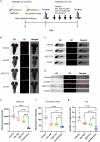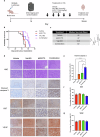Dual treatment with Val-083 and AZD1775 shows potent anti-tumor activity in diffuse midline glioma models
- PMID: 40594881
- PMCID: PMC12215462
- DOI: 10.1038/s41698-025-01006-4
Dual treatment with Val-083 and AZD1775 shows potent anti-tumor activity in diffuse midline glioma models
Abstract
H3K27M diffuse midline gliomas (DMG) are characterized by p53 mutations and hypomethylation of MGMT, a DNA-repair enzyme, leading to resistance towards chemotherapeutic agents such as temozolomide (TMZ). As an alternative, we investigated the efficacy of a functionally different DNA-damaging agent, Val-083, on our DMG models. Val-083 is a blood-brain barrier penetrant DNA targeting agent that induces DNA N7-guanine interstrand crosslinks, which is unrepairable by MGMT. As Val-083 also triggers S/G2 phase cell cycle arrest for DNA repair, we evaluated its combined efficacy with Wee1 inhibitor, AZD1775. AZD1775 functions by inhibiting Wee1, at G2/M checkpoint to prevent phosphorylation of CDK1 and propel cells into the M phase. This subsequently overrides cell cycle arrest and drives cells with DNA damage into premature mitosis and apoptosis. Our results showed that Val-083 and AZD1775 work additively on a range of p53 mutant and p53 wildtype DMG models to inhibit cell growth, induce DNA damage and alter cell cycle. In addition, the combination drugs led to significant increase in the number of cells undergoing apoptosis, and a decrease in the migration and invasion activity of the cells. In vivo, the combination of both drugs led to significant reduction in tumor growth in zebrafish xenograft models and prolongation of survival in mice xenograft models. Our findings indicate that Val-083 and AZD1775 in combination demonstrate promising efficacy in DMGs, providing a clinical rationale for positioning these arms in future therapies.
© 2025. The Author(s).
Conflict of interest statement
Competing interests: The authors declare no competing interests.
Figures






Similar articles
-
The effectiveness and cost-effectiveness of carmustine implants and temozolomide for the treatment of newly diagnosed high-grade glioma: a systematic review and economic evaluation.Health Technol Assess. 2007 Nov;11(45):iii-iv, ix-221. doi: 10.3310/hta11450. Health Technol Assess. 2007. PMID: 17999840
-
Integrated analyses reveal two molecularly and clinically distinct subtypes of H3 K27M-mutant diffuse midline gliomas with prognostic significance.Acta Neuropathol. 2024 Sep 10;148(1):40. doi: 10.1007/s00401-024-02800-3. Acta Neuropathol. 2024. PMID: 39256213 Free PMC article.
-
Systemic pharmacological treatments for chronic plaque psoriasis: a network meta-analysis.Cochrane Database Syst Rev. 2021 Apr 19;4(4):CD011535. doi: 10.1002/14651858.CD011535.pub4. Cochrane Database Syst Rev. 2021. Update in: Cochrane Database Syst Rev. 2022 May 23;5:CD011535. doi: 10.1002/14651858.CD011535.pub5. PMID: 33871055 Free PMC article. Updated.
-
Purine salvage promotes treatment resistance in H3K27M-mutant diffuse midline glioma.Cancer Metab. 2024 Apr 9;12(1):11. doi: 10.1186/s40170-024-00341-7. Cancer Metab. 2024. PMID: 38594734 Free PMC article.
-
Systemic pharmacological treatments for chronic plaque psoriasis: a network meta-analysis.Cochrane Database Syst Rev. 2017 Dec 22;12(12):CD011535. doi: 10.1002/14651858.CD011535.pub2. Cochrane Database Syst Rev. 2017. Update in: Cochrane Database Syst Rev. 2020 Jan 9;1:CD011535. doi: 10.1002/14651858.CD011535.pub3. PMID: 29271481 Free PMC article. Updated.
References
-
- Louis, D. N. et al. The 2016 World health organization classification of tumors of the central nervous system: a summary. Acta Neuropathol.131, 803–20 (2016). - PubMed
-
- Hoffman, L. M. et al. Clinical, radiologic, pathologic, and molecular characteristics of long-term survivors of diffuse intrinsic pontine glioma (DIPG): a collaborative report from the international and european society for pediatric oncology dipg registries. J. Clin. Oncol.36, 1963–72 (2018). - PMC - PubMed
LinkOut - more resources
Full Text Sources
Research Materials
Miscellaneous

